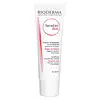What's inside
What's inside
 Key Ingredients
Key Ingredients

No key ingredients
 Benefits
Benefits

 Concerns
Concerns

 Ingredients Side-by-side
Ingredients Side-by-side

Water
Skin ConditioningCetearyl Ethylhexanoate
EmollientCetearyl Isononanoate
EmollientButyrospermum Parkii Butter
Skin ConditioningDiglycerin
HumectantButylene Glycol
HumectantGlycerin
HumectantPolymethyl Methacrylate
Propylheptyl Caprylate
EmollientPtfe
Tapioca Starch
Cetyl Alcohol
EmollientPentaerythrityl Distearate
EmulsifyingSteareth-2
EmulsifyingSteareth-21
CleansingMethicone
EmollientPhenoxyethanol
PreservativeBrassica Campestris Sterols
EmollientGlyceryl Stearate
EmollientPEG-100 Stearate
Rubus Idaeus Seed Oil
EmollientSodium Polyacrylate
AbsorbentCI 77891
Cosmetic ColorantMica
Cosmetic ColorantAcrylates Copolymer
Tocopheryl Acetate
AntioxidantXanthan Gum
EmulsifyingPanax Ginseng Root Extract
EmollientBiosaccharide Gum-1
HumectantAsiaticoside
AntioxidantPhytosphingosine
Skin ConditioningSorbitol
HumectantMaltodextrin
AbsorbentPolymethylsilsesquioxane
Ascophyllum Nodosum
Skin ConditioningSus Extract
Skin ConditioningAsparagopsis Armata Extract
Skin ProtectingPotassium Sorbate
PreservativeSodium Hydroxide
BufferingWater, Cetearyl Ethylhexanoate, Cetearyl Isononanoate, Butyrospermum Parkii Butter, Diglycerin, Butylene Glycol, Glycerin, Polymethyl Methacrylate, Propylheptyl Caprylate, Ptfe, Tapioca Starch, Cetyl Alcohol, Pentaerythrityl Distearate, Steareth-2, Steareth-21, Methicone, Phenoxyethanol, Brassica Campestris Sterols, Glyceryl Stearate, PEG-100 Stearate, Rubus Idaeus Seed Oil, Sodium Polyacrylate, CI 77891, Mica, Acrylates Copolymer, Tocopheryl Acetate, Xanthan Gum, Panax Ginseng Root Extract, Biosaccharide Gum-1, Asiaticoside, Phytosphingosine, Sorbitol, Maltodextrin, Polymethylsilsesquioxane, Ascophyllum Nodosum, Sus Extract, Asparagopsis Armata Extract, Potassium Sorbate, Sodium Hydroxide
Water
Skin ConditioningParaffinum Liquidum
EmollientGlycerin
HumectantTridecyl Trimellitate
EmollientGlycol Palmitate
EmulsifyingCaprylic/Capric Triglyceride
MaskingTriceteareth-4 Phosphate
EmulsifyingFructooligosaccharides
HumectantMannitol
HumectantPersea Gratissima Oil Unsaponifiables
Skin ConditioningXylitol
HumectantGlycol Stearate
EmollientPEG-2 Stearate
EmulsifyingAcrylates/C10-30 Alkyl Acrylate Crosspolymer
Emulsion StabilisingGlycyrrhetinic Acid
Skin ConditioningPentylene Glycol
Skin Conditioning1,2-Hexanediol
Skin ConditioningCaprylyl Glycol
EmollientDisodium EDTA
Xanthan Gum
EmulsifyingLaminaria Ochroleuca Extract
Skin ConditioningRhamnose
HumectantSodium Hydroxide
BufferingWater, Paraffinum Liquidum, Glycerin, Tridecyl Trimellitate, Glycol Palmitate, Caprylic/Capric Triglyceride, Triceteareth-4 Phosphate, Fructooligosaccharides, Mannitol, Persea Gratissima Oil Unsaponifiables, Xylitol, Glycol Stearate, PEG-2 Stearate, Acrylates/C10-30 Alkyl Acrylate Crosspolymer, Glycyrrhetinic Acid, Pentylene Glycol, 1,2-Hexanediol, Caprylyl Glycol, Disodium EDTA, Xanthan Gum, Laminaria Ochroleuca Extract, Rhamnose, Sodium Hydroxide
 Reviews
Reviews

Ingredients Explained
These ingredients are found in both products.
Ingredients higher up in an ingredient list are typically present in a larger amount.
Glycerin is already naturally found in your skin. It helps moisturize and protect your skin.
A study from 2016 found glycerin to be more effective as a humectant than AHAs and hyaluronic acid.
As a humectant, it helps the skin stay hydrated by pulling moisture to your skin. The low molecular weight of glycerin allows it to pull moisture into the deeper layers of your skin.
Hydrated skin improves your skin barrier; Your skin barrier helps protect against irritants and bacteria.
Glycerin has also been found to have antimicrobial and antiviral properties. Due to these properties, glycerin is often used in wound and burn treatments.
In cosmetics, glycerin is usually derived from plants such as soybean or palm. However, it can also be sourced from animals, such as tallow or animal fat.
This ingredient is organic, colorless, odorless, and non-toxic.
Glycerin is the name for this ingredient in American English. British English uses Glycerol/Glycerine.
Learn more about GlycerinSodium Hydroxide is also known as lye or caustic soda. It is used to adjust the pH of products; many ingredients require a specific pH to be effective.
In small amounts, sodium hydroxide is considered safe to use. However, large amounts may cause chemical burns due to its high alkaline.
Your skin has a natural pH and acid mantle. This acid mantle helps prevent harmful bacteria from breaking through. The acid mantle also helps keep your skin hydrated.
"Alkaline" refers to a high pH level. A low pH level would be considered acidic.
Learn more about Sodium HydroxideWater. It's the most common cosmetic ingredient of all. You'll usually see it at the top of ingredient lists, meaning that it makes up the largest part of the product.
So why is it so popular? Water most often acts as a solvent - this means that it helps dissolve other ingredients into the formulation.
You'll also recognize water as that liquid we all need to stay alive. If you see this, drink a glass of water. Stay hydrated!
Learn more about WaterXanthan gum is used as a stabilizer and thickener within cosmetic products. It helps give products a sticky, thick feeling - preventing them from being too runny.
On the technical side of things, xanthan gum is a polysaccharide - a combination consisting of multiple sugar molecules bonded together.
Xanthan gum is a pretty common and great ingredient. It is a natural, non-toxic, non-irritating ingredient that is also commonly used in food products.
Learn more about Xanthan Gum